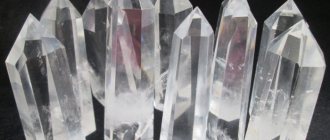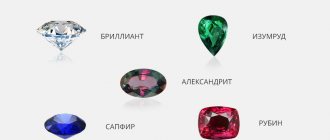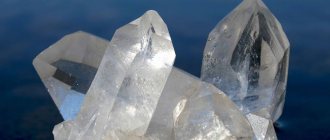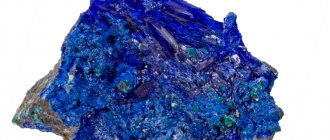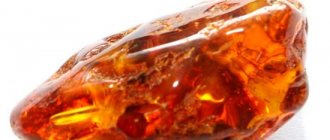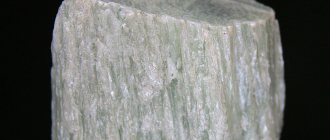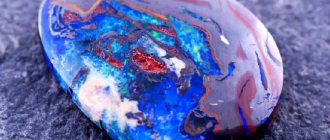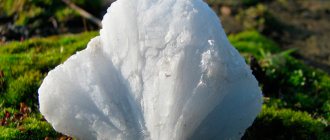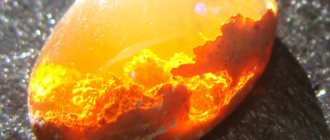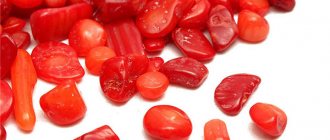| Category | Oxides (minerals) |
| Title in English | Quartz |
| Formula | SiO2 |
| Group | Group of glass-forming oxides |
| Color | White, Colorless, Yellow, Red, Green, Brown, Pink, Orange, Grey, Purple, Black |
| Stroke color | White |
| Shine | Glass, Bold, Matte |
| Transparency | Transparent |
| singonia | Trigonal |
| Hardness | 7 |
| Cleavage | Imperfect |
| Density, g/cm³ | 2,6 — 2,65 |
| Kink | Conchoidal |
| origin of name | The word quartz came to us from the German language, however, there are two versions of its translation. According to the first, to create termani “quartz” they used the word “quarz”, which translates as solid. According to the second option, they used “querklüfterz,” which literally translates as “ore of sparkling veins.” |
Quartz, a polymorph of silicon dioxide, is one of the most common minerals on our planet; it serves as a rock-forming mineral for many rocks of igneous and metamorphic origin. The earth's crust contains about 12% pure quartz and more than 60% in other stones.
Physico-chemical characteristics of quartz
Pure quartz is colorless or white when it contains cracks and other defects.
Its chemical composition is silicon dioxide. Quartz crystals that are colorless and free from defects are known as rock crystal and are used as a gemstone in their own right. Due to admixtures of other elements, such as iron oxides, quartz is colored in different shades. For example, morion is black, amethyst is purple, and citrine has a yellow tint.
— Advertising —
Quartz is characterized by polymorphism. Under normal conditions, α-quartz, also known as the low-temperature modification, is stable. By β-quartz we mean its high-temperature subtype. Independent polymorphic modifications of quartz include cristobalites, tridymites, coesites, and stishovites.
Quartz crystals are oblong hexagons that look like a sharpened pencil. Often form drusen. Large brushes are formed from small crystals.
Quartz has a trigonal system and conchoidal fracture. Hardness on the Mohs scale 7. Specific gravity 2.6 g/cm3. The mineral is soluble in alkalis and hydrofluoric acid. Its melting point is from 1713 to 1728 °C. It has dielectric and piezoelectric properties.
What is a stone
The official list of minerals does not include the position “sugar quartz”. A translucent white crystal is one of the varieties of white quartz. There are two of them:
- milky – evenly colored;
- sugar or snow quartz - resembles glass with frosty patterns.
The mineral is also called snow because it looks like a snowstorm.
For the aristocrats of Ancient Greece, the stone was important as a natural cooler in the heat: it was simply held in their hands.
The term "Sugar Quartz" is more used by trade.
Types of Quartz
- Aventurines are colored yellow or brownish-red.
- Agates are distinguished by a layered-banded structure.
- Amethysts are endowed with an exquisite purple color.
- Binghemites are iridescent quartz with an admixture of goethites.
- Hairworms are a type of rock crystal that contains fine-needle crystals of rutiles and tourmalines.
- Rock crystal is colorless and transparent quartz.
- Flint is a fine-grained cryptocrystalline aggregate of silica with a variable composition, which includes quartz, chalcedony, cristobalite, and occasionally opal.
- Morions are black quartz.
- Overflows are opaque stones that are a mixture of quartz and chalcedony.
- Prazemes contain actinolite, which is why they are colored green.
- Prasiolites are onion-green minerals obtained by calcination of yellow quartz.
- Rauchtopazes (smoky quartz) – painted in gray or brown light tones.
- Rose quartz.
- Chalcedony is a cryptocrystalline fine-fiber stone. Translucent or translucent, painted white or honey yellow
- Citrines are lemon-yellow gems.
- Sapphire quartz is colored blue and has a coarse-grained structure.
- Cat's eye is a stone of white, pinkish or gray color with iridescence and unusual light reflection.
- Hawkeye - quartz intergrowths with bluish-gray amphibole.
- Tiger's eye is golden brown in color.
- Onyxes are brown minerals with patterns of white and black, also found in shades of red-brown, brown-yellow, honey, white with yellow or pink layers.
- Heliotropes are opaque dark green stones with red stripes or spots, which consist of fine-grained quartz, chalcedony, and iron compounds.
Compatibility with zodiac signs
The stone suits all zodiac signs. There are peculiarities, but, in extreme cases, it acts neutrally. It is advisable to choose a color depending on the specific zodiac constellation:
- Aries is better off taking white quartz . The sign is active, persistent, but lacks insight and constancy. The mineral will help fix this.
- A green gem will suit calm, confident Taurus. It will lift your spirits and give you flexibility.
- It is advisable for Gemini to choose yellow or red . These people often come into contact with others, so they would benefit from protection from the evil eye.
- Amethyst is suitable for Cancers. The mineral will soften uncertainty and psychological stress. There is no need to combine it with other gems.
- Pink is favorable for Leos. The stone helps them express themselves more fully and implement creative plans.
- Virgos need to pay attention to sugar . This variety protects from unnecessary thoughts, especially unpleasant ones.
- Cactus quartz is recommended for Libra . Harmony and love are especially important for these people. The stone will suggest the right solutions in conflict situations.
- For Scorpios, hairy beans are suitable, preferably with an admixture of rutile . It complements natural insight. It becomes easier for Scorpios to implement ideas.
- Sagittarians are advised to wear red and pink . The stone protects against rash actions and makes representatives of the sign more diplomatic.
- Capricorns need smoky quartz. It helps overcome isolation. In communication, Capricorns gain additional strength and become more cheerful.
- It is advisable for extraordinary Aquarius to take golden . The stone develops talents and helps bring “inventions” to other people.
- Blue will suit dreamy Pisces. The gem protects from unnecessary mental trauma and helps to develop spiritually.
Some types of stone patronize several signs. For example, green, in addition to Taurus, can be worn by Libra and Aquarius. White quartz (crystal) is also suitable for Leos, Pisces and Scorpios.
Magical properties of quartz
Quartz attracts love, luck, success and financial well-being to its owner, helps to develop imagination and think actively, creatively.
Of all quartz, the most magically valuable is rock crystal. This stone has a high energy potential and can be programmed to help achieve any goals. Milk quartz is used for meditation, in order to free thoughts and go deeper within oneself. Smoky quartz is suitable for business people and becomes an excellent assistant in making important decisions. Amethysts and chrysoprase give peace. Carnelian is a symbol of fidelity.
All quartz have a calming effect, relieve fears and help cope with stress. They are also good at clearing rooms of negative energy.
Healing properties of quartz
Quartz has a good effect on the respiratory system.
Quartz crystals can alleviate colds. Traditional medicine widely uses quartz water, which is made by infusing water with quartz or passing ordinary water through a special quartz filter. It is believed that such water is endowed with many beneficial properties, is useful in the prevention of various diseases, stimulates and rejuvenates the body. It is also used in cosmetology. Washing with quartz water gives the skin elasticity, smoothness and firmness, smooths out wrinkles, and eliminates acne. In addition, lotions and compresses with quartz water are used to treat bruises, burns, cuts, and inflammatory processes on the skin.
Industries using quartz
Quartz has found application in the design of optical instruments, ultrasound generators, telephone and radio equipment, electronic devices, and refractory materials.
It is simply irreplaceable in the production of glass and ceramics. As a glass-forming oxide, it is the primary glass produced from pure silica, rock crystal, vein quartz and quartz sand. Varieties of quartz with beautiful structure, shape and unusual coloring are very popular in jewelry.
Crafting a daylight sensor
The purpose of this sensor is to construct a number of mechanisms, for example, automatic adjustment of lighting at night.
To craft a sensor, arrange your resources as follows:
- Top row: three glasses;
- Middle row: three quartz;
- Bottom row: three wooden slabs.
Artificial quartz
Today, artificial quartz is produced using the hydrothermal method. It is widely used for industrial purposes as it is homogeneous and chemically pure. In this case, single crystals are always grown whose piezo-optical properties are better expressed than those of natural minerals.
When it comes to jewelry, synthetic methods make it possible to create quartz in a variety of colors. For example, very rare green quartz or a pure blue variety that does not exist at all in nature. The production of synthetic quartz is widespread in Russia.
SELECTION AND CARE
When to buy and how much does it cost
Both weekdays and holidays are favorable for purchasing a multi-faceted multi-colored stone.
Care
Most quartz, with the exception of pink or black, are often found in nature, so the price of such stones is usually low - only 100 rubles per crystal.
How to distinguish artificial from natural
The main thing is to be able to distinguish natural quartz from a fake:
- The gem has muted tones.
- If citrine is found with a very bright color, it is most likely fired at high temperatures.
- The purple color is given to the mineral by radiation treatment.
How to distinguish real quartz from a fake
Quartz counterfeits are rare, as this mineral is quite common. Imitations are usually made for its rare varieties. Thus, fake rose quartz is created by coloring smoky quartz with iron and manganese. Such dyes cannot penetrate deeply and produce an uneven color, which also oxidizes easily and loses its visual appeal.
Mining locations
As mentioned, quartz is found on all continents, and within the continents - in the territories of many states. But in different areas, different subspecies of quartz are mined.
Quartz
Quartz and all its varieties are mined by quarrying or by sifting and manual searching in placer rocks. It is found in limestones and dolomites, where whole druses are often found. In placers, this mineral occurs in the form of pebbles, rounded pebbles, and the nature and nature of the placer can be anything. Quartzites are found in mountains, in lowland areas, in river deltas, on the shores of seas, and so on. Even sand is based on quartz compounds; monomineral quartz sand is found (and has great industrial value).
In Russia, the main quartzite mining areas are concentrated in the Urals, Siberia (Yakutia), in certain regions of the Caucasus and in the Far East (placers in Chukotka). It is found in Priochye and even in the Moscow region.
Among other countries, the following countries can boast of large deposits of valuable jewelry and industrial stones:
- Ukraine;
- Uruguay;
- Brazil;
- Kazakhstan;
- USA;
- Mexico;
- the island states of Sri Lanka (formerly Ceylon) and Madagascar.
